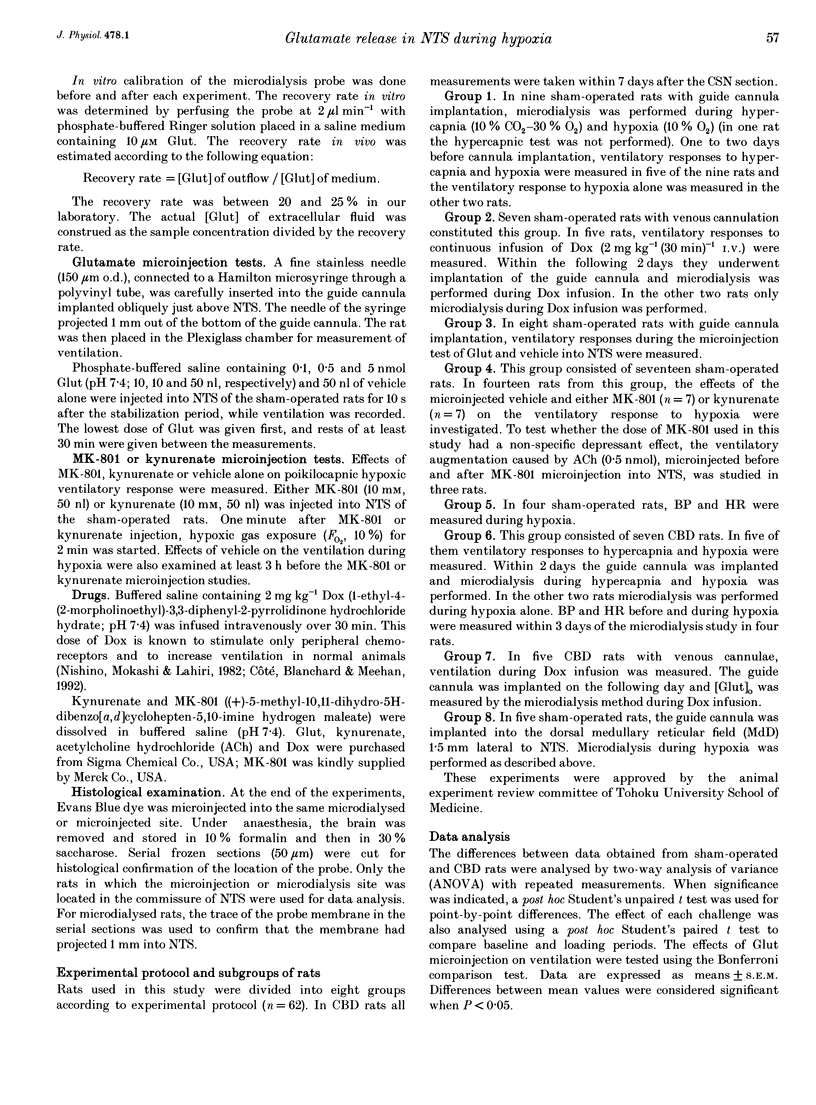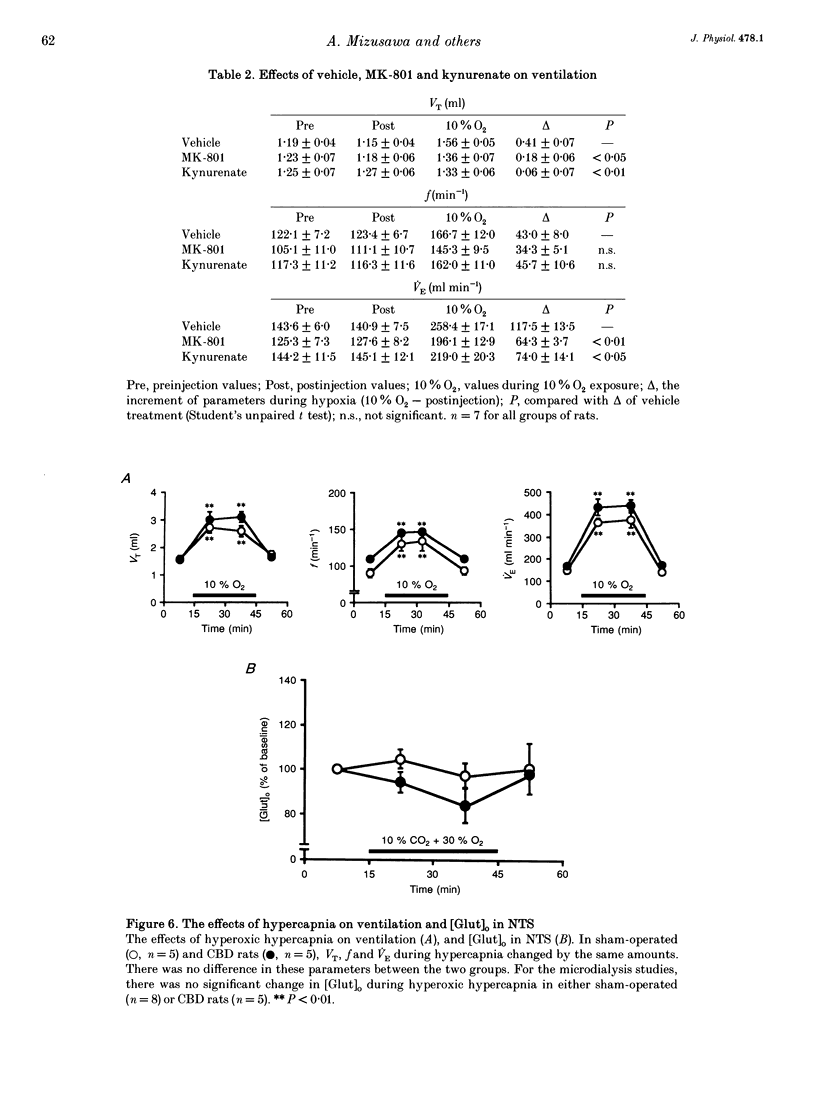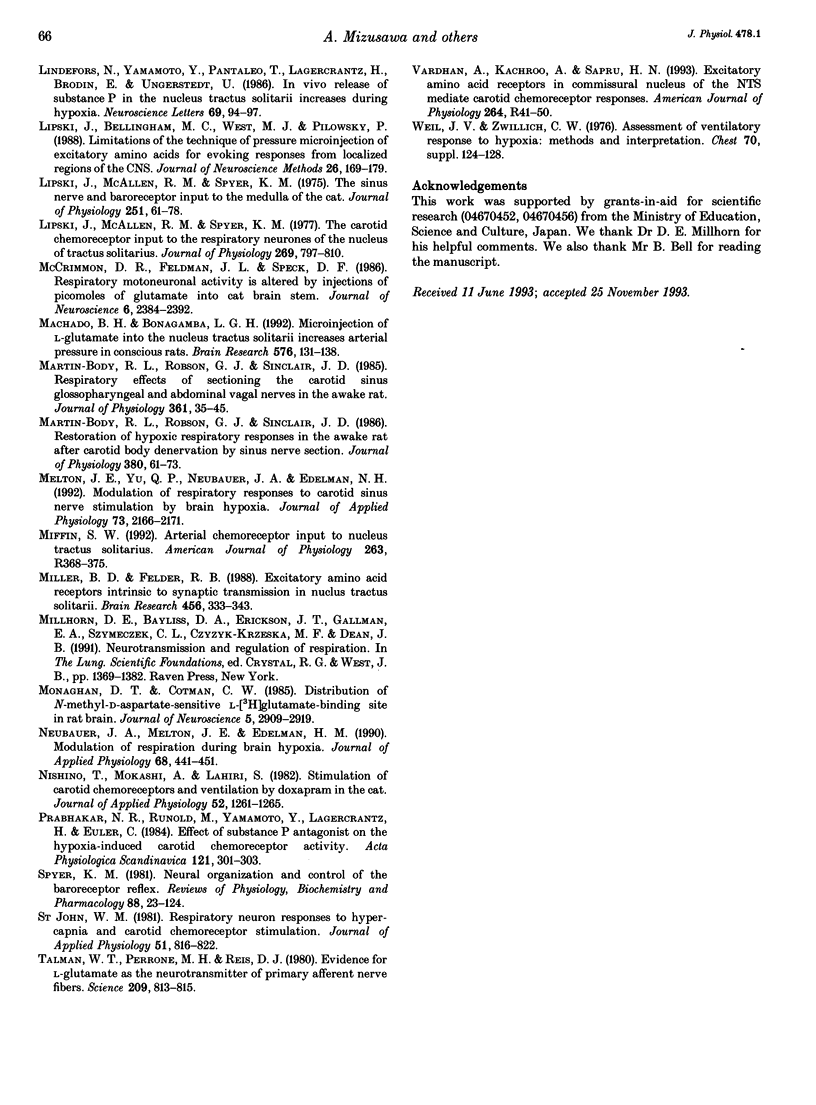Abstract
1. An attempt has been made to test the hypothesis that, in the caudal part of nucleus tractus solitarii (NTS) where carotid sinus nerve (CSN) afferents project, L-glutamate (Glut) modulates the hypoxic ventilatory response. 2. Unanaesthetized, peripherally chemodenervated (carotid body denervated; CBD) and sham-operated, freely moving rats were used. During peripheral chemoreceptor stimulation by hypoxia (10% O2 for 30 min) or doxapram (Dox) infusion (2 mg kg-1 (30 min)-1), ventilation was recorded and successively, under the same conditions, the extracellular Glut concentration ([Glut]o) in the caudal NTS was measured by in vivo microdialysis. [Glut]o was also measured during hyperoxic hypercapnia (10% CO2-30% O2 for 30 min). 3. Furthermore, the effects on ventilation of exogenous Glut, the NMDA (N-methyl-D-aspartate) receptor antagonist MK-801 or the ionotropic receptor antagonist kynurenate microinjected into the caudal NTS were investigated in sham-operated rats. 4. In sham-operated rats, both ventilation and [Glut]o in NTS were increased during peripheral chemoreceptor stimulation. On the other hand, no increases in either ventilation or Glut release were observed in CBD rats. In spite of ventilatory augmentation during hypercapnia, no response of [Glut]o to hypercapnia was observed in either group. 5. Local Glut application into NTS increased ventilation. Pretreatment with MK-801 or kynurenate reduced the hypoxic ventilatory response. This reduction in ventilation was mainly due to the decrease in tidal volume. 6. These results suggest that hypoxia induced the release of Glut in NTS and that this effect was mediated by arterial chemosensory input.
Full text
PDF











Images in this article
Selected References
These references are in PubMed. This may not be the complete list of references from this article.
- Ang R. C., Hoop B., Kazemi H. Role of glutamate as the central neurotransmitter in the hypoxic ventilatory response. J Appl Physiol (1985) 1992 Apr;72(4):1480–1487. doi: 10.1152/jappl.1992.72.4.1480. [DOI] [PubMed] [Google Scholar]
- Bartlett D., Jr, Tenney S. M. Control of breathing in experimental anemia. Respir Physiol. 1970 Oct;10(3):384–395. doi: 10.1016/0034-5687(70)90056-3. [DOI] [PubMed] [Google Scholar]
- Chae L. O., Melton J. E., Neubauer J. A., Edelman N. H. Phrenic and sympathetic nerve responses to glutamergic blockade during normoxia and hypoxia. J Appl Physiol (1985) 1993 Apr;74(4):1954–1963. doi: 10.1152/jappl.1993.74.4.1954. [DOI] [PubMed] [Google Scholar]
- Chiang C. H., Pappagianopoulos P., Hoop B., Kazemi H. Central cardiorespiratory effects of glutamate in dogs. J Appl Physiol (1985) 1986 Jun;60(6):2056–2062. doi: 10.1152/jappl.1986.60.6.2056. [DOI] [PubMed] [Google Scholar]
- Claps A., Torrealba F. The carotid body connections: a WGA-HRP study in the cat. Brain Res. 1988 Jul 5;455(1):123–133. doi: 10.1016/0006-8993(88)90121-7. [DOI] [PubMed] [Google Scholar]
- Connelly C. A., Otto-Smith M. R., Feldman J. L. Blockade of NMDA receptor-channels by MK-801 alters breathing in adult rats. Brain Res. 1992 Nov 20;596(1-2):99–110. doi: 10.1016/0006-8993(92)91537-o. [DOI] [PubMed] [Google Scholar]
- Côté A., Blanchard P. W., Meehan B. Metabolic and cardiorespiratory effects of doxapram and theophylline in sleeping newborn piglets. J Appl Physiol (1985) 1992 Feb;72(2):410–415. doi: 10.1152/jappl.1992.72.2.410. [DOI] [PubMed] [Google Scholar]
- DRORBAUGH J. E., FENN W. O. A barometric method for measuring ventilation in newborn infants. Pediatrics. 1955 Jul;16(1):81–87. [PubMed] [Google Scholar]
- Donoghue S., Felder R. B., Jordan D., Spyer K. M. The central projections of carotid baroreceptors and chemoreceptors in the cat: a neurophysiological study. J Physiol. 1984 Feb;347:397–409. doi: 10.1113/jphysiol.1984.sp015072. [DOI] [PMC free article] [PubMed] [Google Scholar]
- Easton P. A., Slykerman L. J., Anthonisen N. R. Ventilatory response to sustained hypoxia in normal adults. J Appl Physiol (1985) 1986 Sep;61(3):906–911. doi: 10.1152/jappl.1986.61.3.906. [DOI] [PubMed] [Google Scholar]
- Erickson J. T., Millhorn D. E. Fos-like protein is induced in neurons of the medulla oblongata after stimulation of the carotid sinus nerve in awake and anesthetized rats. Brain Res. 1991 Dec 13;567(1):11–24. doi: 10.1016/0006-8993(91)91430-9. [DOI] [PubMed] [Google Scholar]
- Faden A. I., Demediuk P., Panter S. S., Vink R. The role of excitatory amino acids and NMDA receptors in traumatic brain injury. Science. 1989 May 19;244(4906):798–800. doi: 10.1126/science.2567056. [DOI] [PubMed] [Google Scholar]
- Gatti P. J., Norman W. P., Taveira Dasilva A. M., Gillis R. A. Cardiorespiratory effects produced by microinjecting L-glutamic acid into medullary nuclei associated with the ventral surface of the feline medulla. Brain Res. 1986 Sep 3;381(2):281–288. doi: 10.1016/0006-8993(86)90078-8. [DOI] [PubMed] [Google Scholar]
- Goiny M., Lagercrantz H., Srinivasan M., Ungerstedt U., Yamamoto Y. Hypoxia-mediated in vivo release of dopamine in nucleus tractus solitarii of rabbits. J Appl Physiol (1985) 1991 Jun;70(6):2395–2400. doi: 10.1152/jappl.1991.70.6.2395. [DOI] [PubMed] [Google Scholar]
- Henry J. L., Sessle B. J. Effects of glutamate, substance P and eledoisin-related peptide on solitary tract neurones involved in respiration and respiratory reflexes. Neuroscience. 1985 Mar;14(3):863–873. doi: 10.1016/0306-4522(85)90149-6. [DOI] [PubMed] [Google Scholar]
- Housley G. D., Sinclair J. D. Localization by kainic acid lesions of neurones transmitting the carotid chemoreceptor stimulus for respiration in rat. J Physiol. 1988 Dec;406:99–114. doi: 10.1113/jphysiol.1988.sp017371. [DOI] [PMC free article] [PubMed] [Google Scholar]
- Lindefors N., Yamamoto Y., Pantaleo T., Lagercrantz H., Brodin E., Ungerstedt U. In vivo release of substance P in the nucleus tractus solitarii increases during hypoxia. Neurosci Lett. 1986 Aug 15;69(1):94–97. doi: 10.1016/0304-3940(86)90421-0. [DOI] [PubMed] [Google Scholar]
- Lipski J., Bellingham M. C., West M. J., Pilowsky P. Limitations of the technique of pressure microinjection of excitatory amino acids for evoking responses from localized regions of the CNS. J Neurosci Methods. 1988 Dec;26(2):169–179. doi: 10.1016/0165-0270(88)90166-5. [DOI] [PubMed] [Google Scholar]
- Lipski J., McAllen R. M., Spyer K. M. The carotid chemoreceptor input to the respiratory neurones of the nucleus of tractus solitarus. J Physiol. 1977 Aug;269(3):797–810. doi: 10.1113/jphysiol.1977.sp011930. [DOI] [PMC free article] [PubMed] [Google Scholar]
- Lipski J., McAllen R. M., Spyer K. M. The sinus nerve and baroreceptor input to the medulla of the cat. J Physiol. 1975 Sep;251(1):61–78. doi: 10.1113/jphysiol.1975.sp011081. [DOI] [PMC free article] [PubMed] [Google Scholar]
- Machado B. H., Bonagamba L. G. Microinjection of L-glutamate into the nucleus tractus solitarii increases arterial pressure in conscious rats. Brain Res. 1992 Mar 27;576(1):131–138. doi: 10.1016/0006-8993(92)90618-j. [DOI] [PubMed] [Google Scholar]
- Martin-Body R. L., Robson G. J., Sinclair J. D. Respiratory effects of sectioning the carotid sinus glossopharyngeal and abdominal vagal nerves in the awake rat. J Physiol. 1985 Apr;361:35–45. doi: 10.1113/jphysiol.1985.sp015631. [DOI] [PMC free article] [PubMed] [Google Scholar]
- Martin-Body R. L., Robson G. J., Sinclair J. D. Restoration of hypoxic respiratory responses in the awake rat after carotid body denervation by sinus nerve section. J Physiol. 1986 Nov;380:61–73. doi: 10.1113/jphysiol.1986.sp016272. [DOI] [PMC free article] [PubMed] [Google Scholar]
- McCrimmon D. R., Feldman J. L., Speck D. F. Respiratory motoneuronal activity is altered by injections of picomoles of glutamate into cat brain stem. J Neurosci. 1986 Aug;6(8):2384–2392. doi: 10.1523/JNEUROSCI.06-08-02384.1986. [DOI] [PMC free article] [PubMed] [Google Scholar]
- Melton J. E., Yu Q. P., Neubauer J. A., Edelman N. H. Modulation of respiratory responses to carotid sinus nerve stimulation by brain hypoxia. J Appl Physiol (1985) 1992 Nov;73(5):2166–2171. doi: 10.1152/jappl.1992.73.5.2166. [DOI] [PubMed] [Google Scholar]
- Miller B. D., Felder R. B. Excitatory amino acid receptors intrinsic to synaptic transmission in nucleus tractus solitarii. Brain Res. 1988 Jul 26;456(2):333–343. doi: 10.1016/0006-8993(88)90236-3. [DOI] [PubMed] [Google Scholar]
- Monaghan D. T., Cotman C. W. Distribution of N-methyl-D-aspartate-sensitive L-[3H]glutamate-binding sites in rat brain. J Neurosci. 1985 Nov;5(11):2909–2919. doi: 10.1523/JNEUROSCI.05-11-02909.1985. [DOI] [PMC free article] [PubMed] [Google Scholar]
- Neubauer J. A., Melton J. E., Edelman N. H. Modulation of respiration during brain hypoxia. J Appl Physiol (1985) 1990 Feb;68(2):441–451. doi: 10.1152/jappl.1990.68.2.441. [DOI] [PubMed] [Google Scholar]
- Nishino T., Mokashi A., Lahiri S. Stimulation of carotid chemoreceptors and ventilation by doxapram in the cat. J Appl Physiol Respir Environ Exerc Physiol. 1982 May;52(5):1261–1265. doi: 10.1152/jappl.1982.52.5.1261. [DOI] [PubMed] [Google Scholar]
- Prabhakar N. R., Runold M., Yamamoto Y., Lagercrantz H., von Euler C. Effect of substance P antagonist on the hypoxia-induced carotid chemoreceptor activity. Acta Physiol Scand. 1984 Jul;121(3):301–303. doi: 10.1111/j.1748-1716.1984.tb07460.x. [DOI] [PubMed] [Google Scholar]
- Spyer K. M. Neural organisation and control of the baroreceptor reflex. Rev Physiol Biochem Pharmacol. 1981;88:24–124. [PubMed] [Google Scholar]
- St John W. M. Respiratory neuron responses to hypercapnia and carotid chemoreceptor stimulation. J Appl Physiol Respir Environ Exerc Physiol. 1981 Oct;51(4):816–822. doi: 10.1152/jappl.1981.51.4.816. [DOI] [PubMed] [Google Scholar]
- Talman W. T., Perrone M. H., Reis D. J. Evidence for L-glutamate as the neurotransmitter of baroreceptor afferent nerve fibers. Science. 1980 Aug 15;209(4458):813–815. doi: 10.1126/science.6105709. [DOI] [PubMed] [Google Scholar]
- Weil J. V., Zwillich C. W. Assessment of ventilatory response to hypoxia: methods and interpretation. Chest. 1976 Jul;70(1 Suppl):124–128. [PubMed] [Google Scholar]



